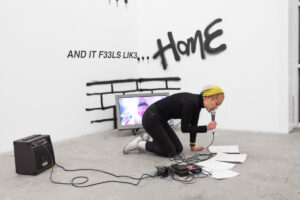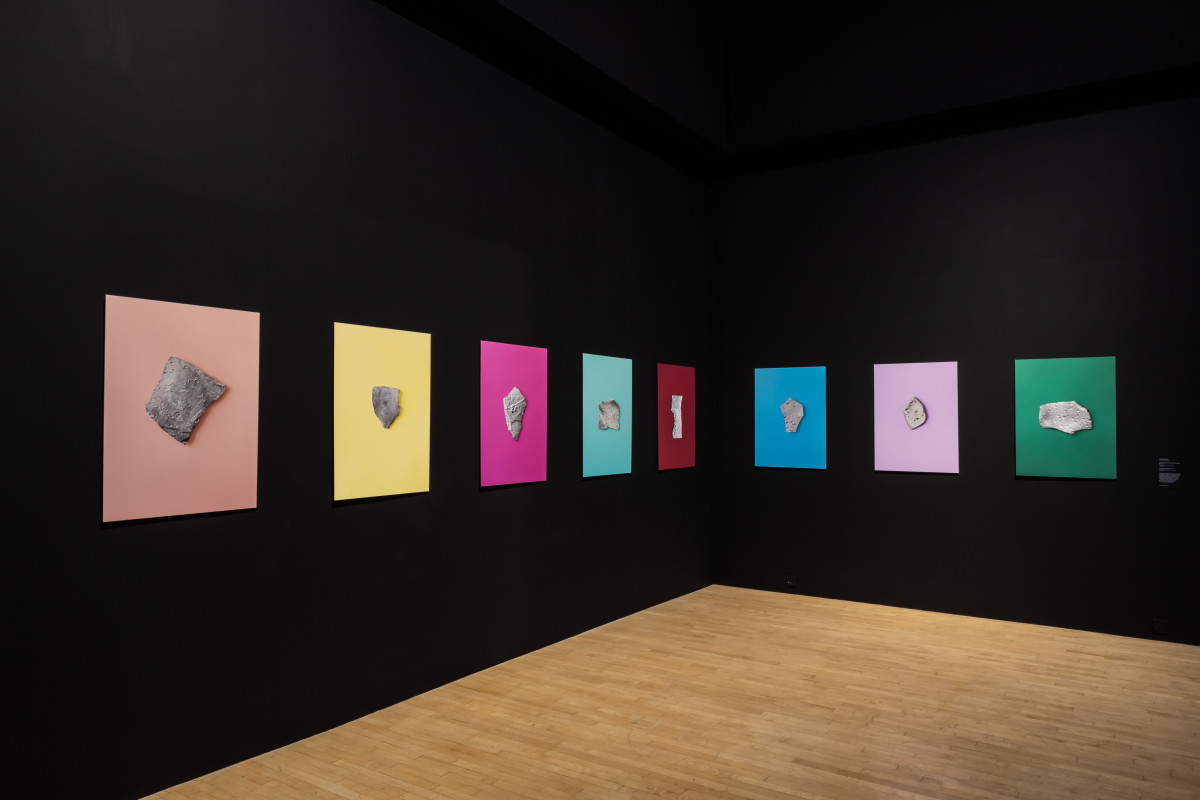Pre-Class Prep, Class Content and Post-Class Investigations
Before the Week 9 class, I examined The Talbot Rice Residents, the Friedlander Foundation’s project, and Candace Lin’s Animal Husbands. They all aim to support artists and promote public engagement, but there are differences in focus. The Talbot Rice Residents emphasize the support and growth of the local arts ecosystem. I inquired after the class that strengthening local arts ecosystems is key to building community identity and cultural sustainability (Bradburne, 2001). According to Art Fund, individuals who participated in local arts activities reported that these activities significantly enhanced their sense of belonging to their community and their perception of community vitality (Art Fund, 2023).
Talbot Rice Gallery,2022. Talbot Rice Residents 2022-2024 | OpenCall YouTube.

Alaya Ang, 'IRVING BERLIN', 2017 (at blip blip blip, Leeds)
The importance of interdisciplinary collaboration in arts promotion is compared to the Freelands Foundation’s (n.d.) approach to promoting arts practices through education and interdisciplinary collaboration. Tate Modern works with programs in the Science, Technology, Arts, and Maths (STEAM) fields, with one event in 2018 attracting over 10,000 participants, most of whom said it was their first visit to an art gallery (Tate, 2018).
Candace Lim’s Animal Husband (Talbot Rice Gallery, 2024) demonstrates the potential of art to inspire society through artistic interventions that challenge conventional understandings of history and biology. This echoes Nicolas Bourriaud’s argument in Post-Production that contemporary art stimulates social reflection by facilitating interaction between viewers and social interaction. Through participatory art practices, Lin’s works ask viewers to actively engage with and interpret them, thereby facilitating exploration and reflection on a wide range of socio-cultural issues, embodying Bourriaud’s emphasis on the role of art as a medium for social and cultural interaction.
These are more international perspectives than the Talbot Rice Residents and the Friedlander Foundation. The comparison leads me to consider the balance between local and global perspectives in curatorial practice. While supporting local art ecosystems is critical to the growth of artists, contemporary art should also serve as a global dialogue to challenge our worldviews.
During the class I went into the Talbot Rice Gallery to experience cross-cultural dialogue and multiple perspectives in curatorial practice, and Bishop (2012) suggests that contemporary curating needs to go beyond the exhibition itself to become a medium that inspires public engagement and social reflection, which corresponds to Candace Lin’s Animal Husbands exhibition on participatory art and its use of audience participation and space.
Later on, ADAM’s tutor’s talk on curatorial project management reflected that curating is not only about art presentation, but also a complex project management practice. This includes precise planning of timelines, space utilisation and budget management. I mapped the conceptual counterparts of these to my personal projects. With a single word limit, I will put the personal project in the next blog in week nine.
Content of the group workshop
During the collective research process, we established and discussed the group’s name around Pili Pala, which aims to explore the stimulation of cross-cultural communication through art. The discussion reflected an understanding of curating as a social practice and cultural intervention. By analyzing all curatorial values such as interculturalism, sustainability, and social responsibility, we highlighted that curating is also a platform for social dialogue and change.
Furthermore, our curatorial practice is inspired by O’Doherty’s (1976) spatial theory (transforming the gallery space into a field of communication and interaction). We developed the project named Domino Project and explored how to promote audience engagement through art making and exhibition layout.
References:
Bishop, C. (2012) Artificial hells : participatory art and the politics of spectatorship. 1st edition. London: Verso.
Bradburne, J. (2001). A new strategic approach to the museum and its relationship to society. museum Management and Curatorship, 19(1), 75-84.
ODOHERTY, B. (1976) INSIDE THE WHITE CUBE – NOTES ON THE GALLERY SPACE .1. Artforum. 14 (7), 24-30.
Graburn, N.H.H. (2014). The Anthropology of Tourism: Heritage and Perspectives. pennsylvania: Channel View Publications.
Talbot Rice Gallery. (n.d.). Talbot Rice Residents. [online] Available at: https://www.trg.ed.ac.uk/residents-1 [Accessed 20 March 2024].
Freelands Foundation. (n.d.). Freelands Artist Programme. [online] Available at: https://freelandsfoundation.co.uk/partnerships/freelands-artist-programme/ [Accessed 19 March 2024]. March 2024].
Talbot Rice Gallery. (2024). Candice Lin: The Animal Husband. [online] Available at: https://www.trg.ed.ac.uk/exhibition/candice-lin-animal-husband [Accessed 20 March 2024 ].
Art Fund. (2019). The Impact of Art Funding on Local Communities. [online] Available at: https://www.artfund.org/our-purpose/news/five-museums-shortlisted-for- art-fund-museum-of-the-year-2023 [Accessed 19 March 2024].
Tate.(2018). STEAM Projects and Public Engagement. [online] Available at: https://www.tate.org.uk [Accessed 18 March 2024].



I will be commenting on ten of your blogs that you have written so far.
First and foremost, each of your blogs clearly expresses the theme of the weekly teaching in the classes and you combine theory and examples through your own independent research to convey the ideas in a simple but accurate way. Secondly, the coherence of your paragraphs and the way you present your reflections is clear. In addition to this, your references to theories are clear. This is crucial for effective blogging and makes it simpler for a wide audience to access your content.
With regards to structure, I think your article is very well structured, as an example of your latest blog, you have divided your article into, pre-class preparation, after-class content and after-class investigation. This very much fulfils the teaching objectives of the lesson.
In terms of content, as I said above, your blog posts are very well structured, but I think that this logical structure can make your blogs wordy and exceed the word count requirement. For example, in Week 8, your blog contained classroom resources to read and after-school independent study, as well as classroom workshop notes, and I think the classroom workshops you could have spread out into a separate blog post to record them. In week 6 of the blog, it is the same problem of too many words. I think your research topic is very interesting. But I would like to give you some advice is that you could try to reduce some of the descriptions of your thinking process. For example, ‘This case inspired me to think….. essence of ephemeral art?’, ‘Whether the…lost due to commercialisation remains to be considered.’ In addition to this, I have seen your research on the art of archiving, and I would suggest that you could research this in the context of the literature we have in this class.
Here are some articles/books for your reference:
Zanella, F., Bignotti, I., Modena, E. & Scotti, M. (2015) MoRE, an archive of signs and traces of artistic practices: creating a tool for research in contemporary art and curatorial practices. Archives and records (Abingdon, England). 36 (1), 56–70. doi:10.1080/23257962.2015.1015260.
Claudia Friedrich (2017) State of the Art Archives | International Conference on Archives Documenting Modern and Contemporary Art. 27 July 2017. Art market studies | Kunstmarktforschung. http://amskoeln.hypotheses.org/1050.
Gül Durukan, S.N. & Tezcan Akmehmet, K. (2020) Uses of the archive in exhibition practices of contemporary art institutions. Archives and records (Abingdon, England). 1–18. doi:10.1080/23257962.2020.1770709.
In addition to this, your blog is very informative and I can see in your content an independent investigation of documentary theory that connects your approach to the field of contemporary curatorial theory and practice.
Regarding the design of the blogs, you have inserted relevant images and videos in each of your blogs and described them correctly. Next, you have customised the blogs as continuous texts, reflecting even more the continuity of your learning process.
In some blogs your posts will be less rigorous. For example, in week 8, the first paragraph,‘However, how do you ensure that art projects…. rather than simply using the community as the context or object of art practice?’I think it exposes the challenge of achieving this understanding in practice: how to avoid the potentially…..is something that must be seriously considered as site-specific arts continue to evolve.’ This content is redundant, it does not support the ‘Place-specific art not only taps into repressed histories and provides greater visibility to…..but also interrogates place’s social and historical dimensions.’, this viewpoint.
Overall, I see that most of your blog is about research and reflection on classroom topics, and although I see that you have mentioned how you will reference the content of your research into your curatorial project, I think it is possible that you may need to do more targeted research on your curatorial theme, form, and location. So I would suggest that you could do some specific research on your curatorial project in the next blogs to make your final curatorial project proposal more accessible.